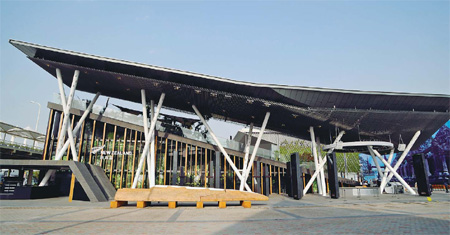New Zealand pavilion lives up to green reputation
 |
| The New Zealand Pavilion places an emphasis on greenery. |
The New Zealand Pavilion welcomes visitors with a traditional dance and a refreshing ambiance.
The greenery and exotic plants featured in the New Zealand Pavilion offer a scenic alternative to the glass and steel structures and countless video productions found in most pavilions in the Expo Garden.
Themed "Cities of Nature: Living Between Land and Sky," the pavilion was designed with the belief that achieving a balance between nature and city life is a vital part of better city living.
At the welcoming plaza, visitors are greeted by a group of young people perform the Kapa Haka, a cultural dance of Maori people perform in New Zealand that is an avenue for Maori to express their heritage and cultural identity through song and dance. The exhibits inside the pavilion take visitors on a journey into the everyday lives of New Zealanders and showcase what the country is so famous for - its beautiful landscapes.
On the roof of the pavilion, a unique garden that features more than 10,000 plants, attracts up to 28,000 visitors a day. Visitors can see 3,200 native New Zealand plants, including silver ferns.
"We had 14 species imported into China. It was quite a complicated process and almost impossible to repeat outside of the Expo," said Tina Hart, one of the garden's landscape designers.
There were also 6,000 locally grown plants used in the remainder of the garden, many masquerading as natives, said Hart. Strict quarantine rules have stopped the designers from bringing more plants in from New Zealand.
"It is common for a New Zealand family to have a backyard garden with some unique New Zealand plants," said Kim Jarrett, another garden landscape designer, who was one of the landscape designers for the film King Kong, which was shot in New Zealand.
"We want to let visitors experience life in New Zealand."
Visitors to the pavilion can also see a reproduction of a thermal lake, common in the Rotorua region of the country.
Trees are also a focal point in the pavilion, with an artificial Pohutukawa tree the highlight. These trees are believed to have existed in New Zealand for centuries. While the tree at the pavilion is artificial, it serves as an icon that expresses the traditional Maori culture to visitors.
"The Pohutukawa tree has a very significant role in New Zealand. The indigenous people believe that it is the path where the sprits get into and leave the world," said Jarrett. "We also recognize the tree is very suitable in China because of its red flowers. We know red is significant for many Chinese," she added.
Though the garden is made up of six parts and designed to highlight different landscapes in New Zealand, Jarrett said it should be appreciated as a whole to show New Zealand's natural landscape.
"If every piece does not tell the same story, we have done our job right," said Jarrett.
"It is interesting to see so many different plants in the pavilion. It made me feel not as tired," said Wang Peng, a visitor to the Expo Garden. "The pavilion offers me a chance to learn more about the country and its culture."
NZ GEMS:
Maori Canoe
A 10-meter-long traditional Maori canoe takes center stage in front of New Zealand Pavilion. The canoe is gift from New Zealand to China. The canoe's carvings are said to be representative motifs of both New Zealand and China. The canoe was only partially completed before it was freighted to China in February and was completed onsite in the Expo Garden. It will be taken to Baoshan district at the end of Expo 2010 Shanghai.
Giant jade
Just before entering the pavilion, visitors will encounter one of the giant highlights of the New Zealand Pavilion - a 1.8-ton pounamu (jade) boulder. As visitors touch the precious stone, they will be touching the heart of New Zealand, according to tradition. The pounamu symbolizes the meeting of two cultures, as the Chinese and Maori share a common reverence for jade.
World's creation
As they enter into the pavilion, visitors pass through a waharoa (gateway) in the form of Tane, a striking, 5-meter-tall stylized carving with animated tattoos. Tane was the son of Rangi and Papa, mythical creations used to explain the origins of the world in Maori culture. The carving depicts the moment Tane prepares to separate from his parents to create the world of light.
 0
0 







Go to Forum >>0 Comments